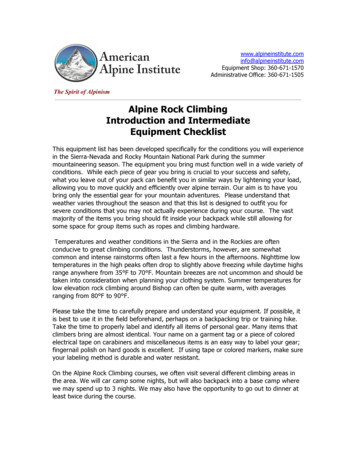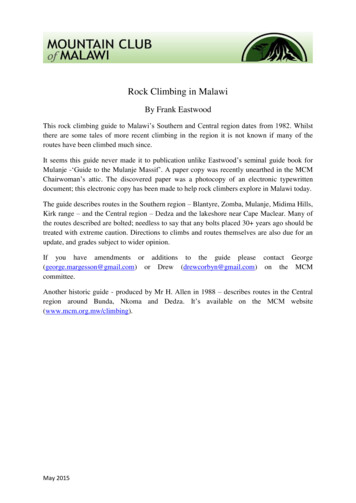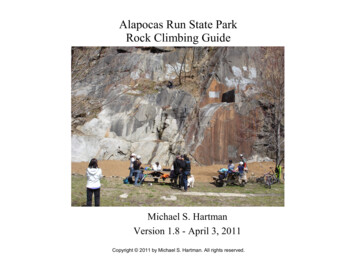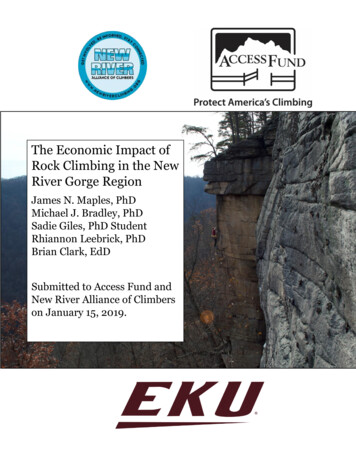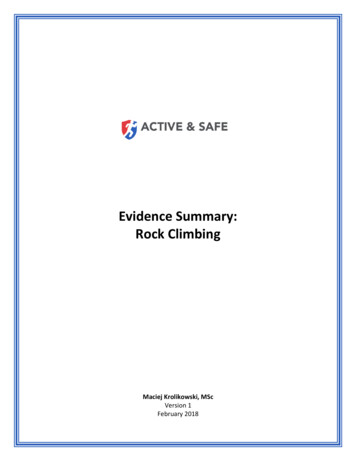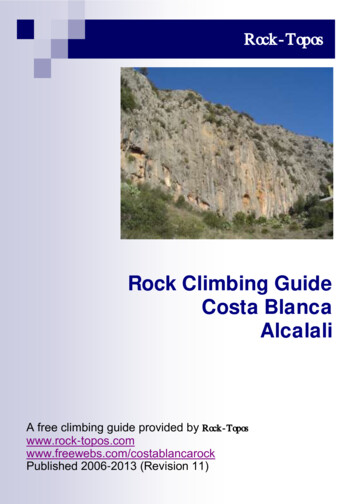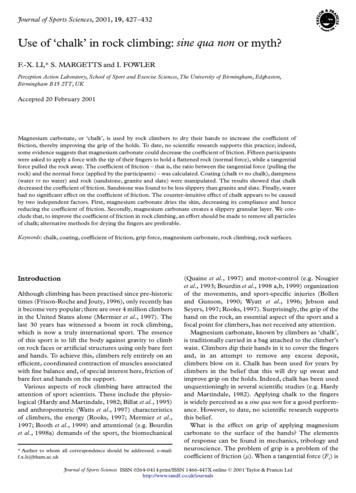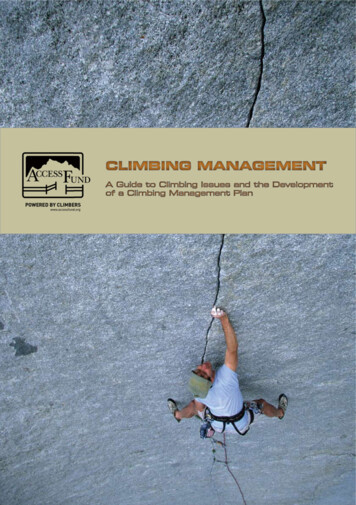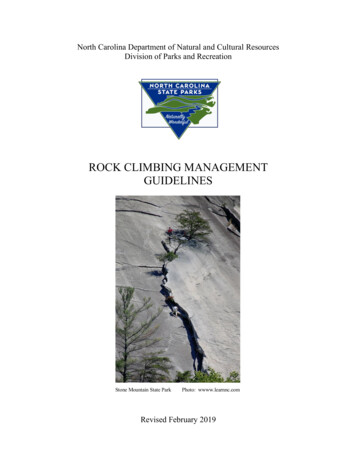
Transcription
North Carolina Department of Natural and Cultural ResourcesDivision of Parks and RecreationROCK CLIMBING MANAGEMENTGUIDELINESStone Mountain State ParkPhoto: wwww.learnnc.comRevised February 2019
ROCK CLIMBING MANAGEMENT GUIDELINESTable of Contents1.0INTRODUCTIONPurpose and Need2.0CLIMBING POLICYPolicyPrecautions3.0GENERAL CLIMBING MANAGEMENTRegulations and Laws Affecting Climbing ManagementPark-Specific PlansCooperative Management4.0CLIMBER REGISTRATION AND PERMITSIndividual ClimbersGroups5.0FIXED ANCHORSFixed Anchor InstallationsFixed Anchor StandardsFixed Anchor Installation MethodsReplacement of Existing Fixed AnchorsInstallation of New Fixed AnchorsBelay/Rappel Station Anchors6.0DESIGNATED CLIMBING ZONES7.0NEW ROUTES8.0ROUTE CLOSURES9.0BOULDERING10.0TOP OUT POLICY11.0LEAVE NO TRACE PRACTICES12.0RESCUE13.0GLOSSARY OF CLIMBING TERMS14.0LITERATURE CITED
1.0INTRODUCTIONThese updated guidelines, established by the North Carolina Division of Parks and Recreation (DPR),replace those issued in 1997. These guidelines are intended to: Provide rock climbing opportunities where appropriate;Protect the natural and cultural environments; andEnsure positive experiences for all park visitors.Rock climbing (defined here to include bouldering, free climbing, ice climbing, and direct aidclimbing) has occurred in North Carolina's state parks since the 1950’s, when routes were establishedin and around Hanging Rock State Park in Stokes County. As the popularity of rock climbingincreased, it became a common recreational activity at three additional state parks: CrowdersMountain, Pilot Mountain, and Stone Mountain. Today, rock climbing also occurs at Chimney RockState Park. Additional climbing areas may be added in the future, subject to DPR approval.As rock climbing's popularity increased, DPR recognized the need to establish regulations regardingaccess, the designation of climbing areas, natural resource protection, and visitor safety. This led tothe establishment of the first DPR climbing policy in 1973. This policy established designatedclimbing areas.In the decades since the adoption of the 1973 policy, the popularity and impact of climbing hasincreased dramatically. This growth has been attributed largely to the availability of modernequipment, the publication of detailed guide books, exposure in the regional and national climbingpress, the proliferation of climbing gyms in urban areas, and increased media exposure (seeAttarian1994).Studies on the impacts of climbing have documented variable but wide-ranging detrimental effects tocliff-face vegetation. These include reductions of vegetation cover, shifts in natural communitydistributions, localized loss of species that are sensitive to such disturbances, and skewed size and agedistributions for some species. North Carolina State Parks have experienced the same impacts as manyareas across the country, including climber crowding, soil compaction, vegetation trampling, erosion,and social trails (See: Attarian and Keith 2008; Walker et al. 2008; McMillan and Wilson 2002;McMillan and Larson 2002; Camp and Knight 1998; Attarian 1994; Attarian 1991; Kascenska andAttarian 1990; and references therein).The 1973 policy was replaced in 1997, largely in response to a system-wide fixed anchor replacementproject undertaken by the Carolina Climbers’ Coalition (CCC). Although collaboration with the CCCand other climbing groups has proven vital in improving climber safety and resource protection,concerns persist regarding climbing management and the long-term protection of the state parksystem's cliff ecosystems. Accordingly, it is prudent to produce updated system-wide and parkspecific climbing management guidelines similar to those produced in collaboration with the climbingcommunity at numerous areas across the country.
2.0CLIMBING POLICY AND PRECAUTIONSPolicyRock climbing in North Carolina State Parks is a recreational activity that, although inherentlydangerous, will be permitted by DPR in specific locations and circumstances and managed inaccordance with DPR’s mission to protect natural resources and provide for the enjoyment of parkvisitors. When managing rock climbing, DPR will strive to Protect natural and cultural resources in and around climbing areas while providing forrecreational climbing;Provide clearly defined regulations and a fact-based decision-making framework;Develop park-specific climbing management plans;Engage the climbing community in cooperative management and stewardship; andProvide a framework for climber and public education, including Leave No Trace ethics.PrecautionsWhile DPR will facilitate climbing by providing parking, access trails, trail maps, and warningsignage, visitors climbing in N.C. State Parks fully assume all risks associated with rock climbing,including, but not limited to, injury (including death), loss or damages, to person, property orotherwise, of any kind resulting from such risks and any associated activities. All DPR units thatprovide climbing as an approved recreational activity will warn visitors via signage of knownobjective hazards in climbing areas such as cliffs, steep terrain, potential rock fall, damaged or closedtrails, etc. Barriers, such as fencing, may be present in some climbing areas. However, DPR cannotguarantee the safety of climbers or other park visitors, and will not provide equipment, supervision orinstruction to climbers.While DPR will designate appropriate climbing areas (see Section 6.0 below), DPR is not responsiblefor maintaining the condition of climbing terrain, climbing routes, or climbing anchors. Further, DPRis not liable for the acts or omissions of others, including, but not limited to the provision of climbinginformation on guidebooks or Internet websites. However, when notified, DPR will post warningsigns regarding known hazards and seek to correct any misinformation provided to the public.3.0GENERAL CLIMBING MANAGEMENTRegulations and Laws Affecting Climbing ManagementThe provision of climbing opportunities will be subject to a variety of policies, rules, regulations, etc.,adopted by DPR, North Carolina, or the United States. For instance, relevant DPR publicationsgoverning climbing management on property owned or managed by DPR include but are not limitedto:3.0.13.0.23.0.33.0.4DPR’s mission statement;DPR’s natural resource management policy;Park-specific climbing management plans; andPark-specific master plans and/or general management plans.Relevant state and federal laws, regulations, and policies will include but are not limited to:3.0.5Endangered Species Act of 1973:7 U.S.C. § 136; 16 U.S.C. § 1531 et seq.
3.0.63.0.73.0.83.0.9NC State Environmental Policy Act: N.C. Gen. Stat. § 113A, Article 1.National Environmental Policy Act: 42 U.S.C. § 4321 et seq.Endangered and Threatened Wildlife and Wildlife Species of Special Concern:N.C. Gen. Stat. §§ 113-331 to 113-337.Plant Protection and Conservation Act: N.C. Gen. Stat. §§ 106-202.12 to 106202.22.Regulations concerning climbing at Parks and Recreation Areas: 07 NCAC13B.0204.Moreover, pursuant to the foregoing laws and policies, as well as additional considerations, issuesaffecting climbing management may include, but are not limited to:3.0.10 A site’s status as a National Natural Landmark;3.0.11 A site’s existence in a State Dedicated Nature Preserve, Significant NaturalHeritage Area, or Registered Natural Heritage Area;3.0.12 The presence or discovery of high quality natural communities;3.0.13 The presence or discovery of state or federally-listed species;3.0.14 Unsustainable or unacceptably severe impacts;3.0.15 Visitor safety, including code compliance for trails, overlooks, railings, etc.;3.0.16 US Fish and Wildlife Service rare species recovery plans; and3.0.17 Fixed anchor safety.Park-Specific PlansFor each park featuring a designated climbing area, the park superintendent will consult with Divisionadministration, Natural Resources Program staff, the Natural Heritage Program, the climbingcommunity, and other relevant sources to develop a park-specific climbing management plan. DPRretains the responsibility for the final wording and approval of said climbing management plans.Park-specific climbing management plans will include provisions addressing the following:3.0.183.0.193.0.203.0.21Parking, access, and hours of operation;Designated climbing areas and access/descent points;Frequency and limitations on group reservations;Natural resource and rare species management and protection.Cooperative ManagementBecause DPR maintains a productive relationship with the climbing community, climbing in NorthCarolina State Parks has remained largely self-regulated. DPR welcomes the opportunity tocollaborate with the climbing community on projects that are mutually beneficial. Examples includeAdopt-a-Crag programs, trail construction and maintenance, anchor maintenance, No Trace Ethicseducation, updating route maps, search and rescue training, etc. It is only through the cooperation ofthese groups that park managers can understand and manage climbing’s impacts, and further, suchcooperation enables climbers to understand DPR’s operational needs and resource protectionmandates.4.0CLIMBER REGISTRATION AND PERMITSA climbing permit is required for individuals, whether or not they are part of a group, prior to rock
climbing at any state park.(15A NCAC 12B.0204 – Rock or Cliff Climbing or Rappelling). Thepermit requirement is necessary for securing emergency contact information, conducting accidentinvestigations, notifying climbers of all associated risk, ensuring compliance with all applicable rules,and coordinating search and rescue efforts. The permit requirement also enables DPR to track usagestatistics which are critical in the review and approval of new or improved facilities (e.g., parking,bathrooms, and trails), as well as in decisions to justify opening additional climbing resources orlimiting access to others. Lastly, the permit requirement allows DPR to inform climbers of the pertinentregulations and allows climbers to acknowledge their understanding and responsibility of the risksinvolved.IndividualsAll climbers must obtain a day-use climbing permit prior to climbing. Free day-use permits areavailable at park offices, online at www.ncparks.gov, and at information kiosks in all climbing areas(see Attachment 1 for a copy of the day-use climbing permit). Climbers must complete and sign theday-use climbing permit prior to climbing, return the white portion to the provided receptacle and retainthe yellow portion of the permit for the duration of their activity. Day-use permits are valid for the datesspecified only. All climbers under the age of eighteen (18) must have a parent or legal guardian signtheir day-use permit prior to participating in any climbing activities at N.C. State Parks.GroupsA group is defined as any organized climbing group, that is guided or instructed by a commercialbusiness, not-for-profit, school, church, club, private organization, or governmental organization. Agroup is defined as greater than five (5) but no greater than fourteen (14) people and DPR recommendsa student to instructor ratio of 6:1.Prior to climbing, all groups must obtain a DPR Group Climbing Application (GCA). The GCA isgood for each group for a period of one year (January through December). The GCA must be resubmitted annually. There is a 35 annual fee which must be submitted with each GCA.As part of the annual GCA, each group must provide proof of having liability insurance in theamount of 1 million/occurrence and 1 million/aggregate (see Attachment 2 for a copy of thegroup climbing application). Once GCA has been completed please email togroupclimbing@ncparks.gov or mail to Lake Norman State Park, 759 State Park Road, Troutman,NC 28166 at least 14 days prior to the first date the group intends to climb.Prior to the climbing event, each group must reserve a space for group climbing using the centralreservation system /welcome.do) or by contactingthe appropriate park office:Chimney Rock State ParkP.O. Box 220Chimney Rock, NC 28720Office: 828-625-1823Crowders Mountain State Park522 Park Office LaneKings Mountain, NC 28086Office: 704-853-53-75
Hanging Rock State Park1790 Hanging Rock Park RoadDanbury, NC 27016-7417Office: 336-593-8480Pilot Mountain State Park1792 Pilot Knob Park RoadPinnacle, NC 27043Office: 336-325-2355Stone Mountain State Park3042 Frank ParkwayRoaring Gap, NC 28668Office 336-957-8185There is a 5 fee for each group climbing event and currently a 3 processing fee for use of the centralreservation system.Park Superintendents will have the discretion to limit the number of groups per day or to designatespecific group climbing areas. Groups may be restricted to minimize natural resource impacts,minimize crowding and provide for a safe recreational opportunity and enhanced visitor experience.On the day of climbing, all climbers must obtain or have previously submitted a climbing day-usepermit prior to climbing. Free permits are available at park offices, online at www.ncparks.gov, and atinformation kiosks in all climbing areas. Climbers must complete and sign the day-use climbing permitprior to climbing, return the white portion or a copy of the permit to the provided receptacle or thePark Superintendent and retain the yellow portion or a copy of the permit for the duration of thegroup’s activity. Day-use permits are valid for the dates specified only. All climbers under the age ofeighteen (18) must have a parent or legal guardian sign their day-use permit prior to participating inany climbing activities at N.C. State Parks.DPR understands that individual climbing groups may have requirements regarding instructor trainingand certification, minimum ages, transportation, accident reporting, etc. DPR expects each climbinggroup to follow these requirements.5.0FIXED ANCHORSAlthough there are hundreds of fixed anchors, primarily expansion bolts, on state park property, fixedanchors can be controversial and DPR’s preference is to minimize their use. Thus, while fixed anchorsare permitted in state parks, DPR reserves the right to prohibit new installation efforts on a case-bycase basis. DPR is not responsible for the installation, use, inspection, or maintenance of any fixedanchors. DPR makes no claims as to any fixed anchor's condition or reliability, and is not responsiblefor anchor information in guidebooks, Internet websites, etc.DPR will not install or replace fixed anchors. Instead, all anchor installation and replacement effortswill be conducted on a volunteer basis by members of the climbing community. Park staff mayprovide logistical coordination of anchor installation and replacement efforts.
Anchor installation and replacement efforts will be coordinated through credible organizationsspecializing in climbing issues, including but not limited to the Carolina Climbers Coalition;professional guide services; Outward Bound; The Access Fund; the American Safe ClimbingAssociation; the American Alpine Association; the AMGA; and the PICA. The selection andcertification of all anchor installation and replacement team members will be the responsibility of theconsulting organization(s).Prior to the project's initiation, all volunteer climbers will be advised in writing by the parkSuperintendent of the Anchor installation projects must comply with DPR’s Volunteer Guidelines;The State will not provide medical coverage or worker's compensation in theevent of an accident;All climbing equipment, tools, and anchor hardware are to be providedby the climbing community;Any material costs associated with anchor installation or replacement willbe borne by the climbing community;Park staff must be notified prior to the initiation of the project, and all workmust occur during posted park operating hours;Old anchors are to be completely removed and carried out. Unless otherwisewarranted, the replacement(s) should occur as close as possible to the oldanchor site(s);Upgrading pitons or other fixed gear with expansion bolts is strongly encouraged;andOn completion of the project, climbers will provide the park superintendentwith written documentation identifying the individual(s) whoinstalled/replaced each anchor and denoting anchor location, type, anddate/method of installation.Fixed Anchor StandardsThe minimum standards for expansion bolts will be a stainless steel 3” x 3/8” wedge anchor, or astainless steel 2.25” x 3/8” sleeve anchor, coupled to a stainless steel hanger. All anchors and hangersmust be rated by the European Committee for Standardization and the International Mountaineeringand Climbing Federation (CE/UIAA). Specialty anchors, such as glue-in bolts, will be considered on acase-by-case basis only after consultation with knowledgeable sources.5.0.95.0.105.0.115.0.125.0.135.0.14Larger and longer anchors are acceptable, and camouflaged anchors areencouraged;Stainless steel ring anchors are preferred (but not required) for belay or rappelstation anchors;Non-climbing specific hardware, such as home-made hangers,construction or masonry anchors, cold shuts, etc., is not allowed;Pitons are strongly discouraged;Existing anchor holes may be used in the installation of replacementanchors whenever possible; andAbandoned anchor holes that are deemed unusable may be patchedwith some form of moldable epoxy putty, preferably colored to matchthe native stone.
Photo: www.fixehardware.comPhoto: www.petzl.comExamples of acceptable anchors.Fixed Anchor Installation Methods5.0.15 Fixed anchors may be installed using either a hand-held drill or power drill;5.0.16 Replacement anchors may be placed on rappel or from the ground-up; and5.0.17 The installation of fixed anchors on new routes from the ground-up, by a leadclimber, or from the top-down, on rappel, will be left to the area’s prevailingclimbing style and may be addressed in park-specific management plans.Replacement of Existing Fixed AnchorsThe replacement of fixed anchors on established routes or belay stations will be allowed wheneverclimbers notify park staff that existing fixed anchors are unsafe. Upon notification, park staff willimmediately post information at climbing information kiosks, permit kiosks, and park offices advisingclimbers that suspect anchors may be present on a specific route. The route in question may remainclosed until repairs are made.Anchor replacement, Pilot Mountain State ParkPhoto: NC DPR
Installation of New Fixed AnchorsThere will be situations where the installation of new fixed anchors is prudent. The placement of newfixed anchors may be allowed for:5.0.18 New climbing routes, but only in sections of the route that have no featuresadequate for the reliable placement of removable hardware such as cammingunits, wired stoppers, etc.;5.0.19 Rappel or belay stations, particularly at the tops of routes and for “No Top Out”areas;5.0.20 Resource protection; and5.0.21 Any situation in which climbers notify DPR of the need for additionalanchors for safety or natural resource protection.Belay/Rappel Station AnchorsIn addition to the anchor standards noted above, all fixed anchor belay and rappel stations will belocated only after due consideration of the following:5.0.225.0.235.0.245.0.25The use of vegetation for belay and rappel anchors is not recommended;Fixed belay/rappel stations must have a minimum of two anchors;CE/UIAA-rated stainless steel ring anchors are preferred but not required;Anchor stations are to be placed to avoid rope drag across obstructions or sharpedges. Where needed, anchors may be lengthened with CE/UIAA-ratedstainless steel chain;5.0.26 Fixed anchor stations are to be installed so that the anchors can be easilyequalized; and5.0.27 Fixed anchor stations are to remain clean of webbing and accessory cord.Photos: www.fixehardware.comPreferred belay/rappel station anchor types.6.0DESIGNATED CLIMBING AREASRecreational access may not be appropriate for each cliff and boulder ecosystem within state parks.Climbing will be allowed only in areas designated by the park superintendent. To be eligible fordesignation as a climbing area, a location must be:
6.0.16.0.26.0.36.0.47.0Entirely on DPR-owned or managed lands;Safely accessible by via either road or trail;The road or trail can be owned by DPR or by a partnership includingDPR and other organizations or agencies; andAmenable to sustainable climbing activities that will not significantly impair apark’s natural or cultural resources.NEW ROUTESThe establishment of new routes may be addressed in park specific climbing management plans. Allnew routes must be located within existing designated climbing areas. In all cases, the following willapply:7.0.1 The removal of rock from its natural position will be allowed only if failure toremove the rock poses a risk to safety (loose slabs, flakes, etc.);7.0.2 Chipping or gluing holds is prohibited; and7.0.3 The intentional removal of vegetation to clean a route is prohibited.8.0ROUTE CLOSURESDPR may close any climbing area to protect wildlife, natural or cultural resources, visitor safety, orvisitor experiences. Seasonal closures may be addressed in park-specific plans. Decisions on route orarea closures will be made after the consideration of the following:8.0.18.0.28.0.38.0.4Sensitivity of plant or animal species or natural communities present within theclimbing zone;Sensitivity of cultural resources present within the climbing zone;Whether climbing activities have or are likely to have an unsustainable,adverse impact on natural or cultural resources; andWhether public or climber safety compromised by leaving the route(s) or area(s)open.When appropriate, DPR staff will collaborate with biologists, safety personnel, climbing communityrepresentatives, and other qualified sources prior to closing climbing routes to determine how to bestaddress any relevant concerns. In some instances, DPR may have no choice but to close routes tocomply with state or federal regulations or conservation strategies. Responsive action may include, butwill not be limited to:8.0.58.0.68.0.7Installing safety measures, such as fencing, railings, trails, or overlooks;Visitor education; rare species monitoring; temporary route closures; andPermanent route closures; installation of new or upgraded anchors or belaystations, etc.The relocation of rare species will be considered only under extreme circumstances. If permanentclosure occurs, then appropriate restoration efforts will be conducted. Any closure will beaccompanied by a public education effort.
Warning sign, Stone MountainPhotos; NC DPR9.0Spreading Avens, Grandfather MountainBOULDERINGBouldering is defined as unroped climbing within a short distance of the ground on rock formationsthat require the use of specialized equipment (rock climbing shoes, chalk, crash pad, etc.) Boulderingmay be addressed in park-specific management plans. Bouldering plans will consider:9.0.19.0.29.0.3The likely impacts to park resources within and adjacent to the proposedbouldering area(s);The likely impacts to park resources along and adjacent to the proposed accessroute(s); andThe likely impacts to other visitor activities and the overall visitor experience.10.0 NO TOP OUT POLICYWhere feasible, DPR climbing areas will adopt a “no top out policy” for all new and establishedroutes, with retreat from the top of any route occurring via fixed anchor stations that are located belowthe rock face’s top edge. This is intended to both alleviate adverse impacts to cliff-top areas and toavoid the unsafe use of vegetation for anchors. Where desirable and feasible, centralized belay/rappelstations may be installed to serve multiple routes.Exceptions to the no top out policy may be allowed at the park superintendent’s discretion, and parkstaff will be encouraged to coordinate with local climbers to establish anchor stations in appropriatelocations. In the absence of a no top out program, park staff and climbers should collaborate to ensureadequate access trails that minimize impacts.11.0 LEAVE NO TRACE PRACTICESDPR will promote responsible, ethical, and environmentally sensitive climbing, which will espousethe National Outdoor Leadership School’s “Leave No Trace” program. DPR staff will collaboratewith climbing groups to educate the park’s climbing community and other visitors in order topromote safe and ethical climbing.
12.0 RESCUEWhile the courts have ruled that public land managers have no duty to rescue climbers or othervisitors who are lost, injured, or killed through engagement in their activity (see Johnson v. UnitedStates, Department of Interior, 949 F.2d 332, 335, (10thCir. 1991); Kiehn v. United States, 984 F.2d1100, 1108, (10th Cir. 1993), DPR may undertake rescue operations unless the risks to rescuepersonnel are deemed unacceptable.This responsibility may be fulfilled by qualified DPR staff or by qualified search-and-rescueorganizations, volunteers, or agencies that are capable of responding to life-threatening emergencies inhigh angle environments. The park may seek additional resources if at any time the incidentcommander believes it is in the best interest of the park, safety of employees and visitors, and/or theinjured or stranded party. Activating outside resources adds to the response time, but in some casesmust be done in order to safely respond. In all cases, efforts will be made to provide the necessarytreatment and services to the sick, injured and stranded. Deceased persons will be evacuated unlessthe level of risk to the rescue party is deemed to be unacceptably high.13.0 GLOSSARY OF CLIMBING TERMSMost of the text of the following glossary is taken directly from Climbing Management: A Guide toClimbing Issues and the Production of a Climbing Management Plan (Access Fund, 2008).Anchor: Any piece of protection used to secure climbers to a cliff face for belaying or rappelling.Most are removable. “Fixed anchors” are left in place for all climbers to use.Belay or belaying: The method by which one climber secures the rope to safeguard the other climberin the event of a fall.Bolt: Bolts are small devices (usually 3/8” diameter by about 3” length) used to protect climberswhere there are no cracks for other types of protection. They are placed by drilling a hole, usingeither a hand-turned or battery-powered drill, and then driving in the device, which is designed to holdthrough mechanical expansion, forced compression, or (rarely) an epoxy adhesive.Bouldering: Bouldering is the term given to climbing that concentrates on short, sequential moves onrock usually no more than 15 feet off the ground. Typically, falls are very short (a few feet) andinconsequential.Chains: Short lengths of metal chain are sometimes used instead of slings at a rappel or belay station.Chalk: Chalk dries the hands and is used in rock climbing in the same way it is used in gymnastics, toimprove grip.Climbing shoes: Snug-fitting shoes with high-friction rubber soles and carefully designed edges thatallow climbers to stand on tiny footholds.Crash Pad: Portable padding placed on the ground and used to safeguard climbers in the event of a fallwhile bouldering.
Fixed anchors: see Anchor and BoltGear: Equipment used for protection (see Anchor and Hardware).Hardware: Climbing equipment placed in cracks or on faces to protect climbers from falling, includingwired nuts, camming devices, pitons, and bolts.Multi-pitch: A climb of two or more roped pitches (see Pitch) in length.Pitch: The distance a lead climber ascends before he or she stops to belay the second climber's ascent.The distance of a pitch is limited by the length of rope and the location of ledges and belay stations.Piton: Small metal spikes, generally two to four inches long, which is placed by hammering it intoexisting cracks in the rock. Pitons are used only when no other form of protection is available, and aretypically left in place for other climbers to use.Protection: Any form of anchor used between belays to protect a climber. It can be removable orfixed.Rappel: The method by which a climber descends a rope, usually by using a mechanical frictiondevice.Rating: A numerical value assigned to indicate the difficulty of the climbing on a particular route.Route: Any independent line of ascent on a rock face. A climb may follow a crack system or othernatural features, or it may strike out across a blank face.Sport climbing: Climbs that are protected exclusively with fixed protection, usually bolts, are calledsport climbs. Sport climbs are typically short – generally a single rope-length (50 to 60meters) orless. They rarely continue to summits, but end at fixed anchors where the sustained difficulty of theclimb diminishes, the character of the rock changes, or simply at the half-rope point to allow theclimber to descend by being lowered.Top rope: Technique of practice climbing where the rope is anchored above the climber.Traditional climbing: A style of climbing where protection is placed by the ascending climber andremoved by the seconding partner. Value is placed on unpracticed ascents. Traditional climbersprogress up the rock face using natural hand-and footholds, with the rope and technical climbingequipment used only for safety in case of a fall. Typically, traditional climbs are protected byequipment that is removable and does not damage the rock surface.14.0 LITERATURE CITEDAttarian, A. 1991. An Investigation of the Ecological and Social Impacts Caused by RockClimbers. Proceedings of the 1991 International Conference on Outdoor Recreation. Moscow,Idaho. pp. 7-15.
Attarian, A. 1994. Management Strategies for Reducing Climbing Related Impacts.Unpublished manuscript. 33 pp.Attarian, A., and Jason Keith. 2008. Climbing Management: A Guide to Climbing Issues andthe Production of a Climbing Management Plan. 7
Rock climbing in North Carolina State Parks is a recreational activity that, although inherently dangerous, will be permitted by DPR in specific locations and circumstances and managed in accordance with DPR’s mission to protec
